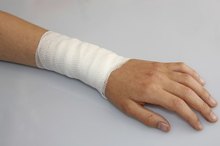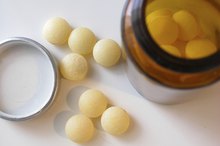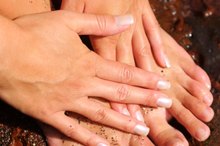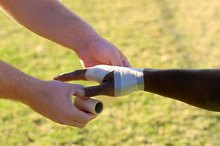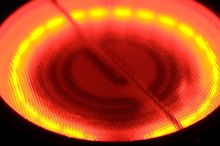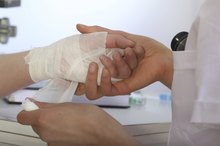Vitamin E Oil for Burns
Roughly 1 to 2 million people in the United States require medical attention every year after sustaining burns. Whether this painful injury is a result of sun exposure or exposure to heat, chemicals or electricity, the damage that it does to skin requires treatment to minimize lasting effects, promote healing and reduce the likelihood of scarring. Vitamin E oil is an effective natural treatment. Use it on its own or in combination with vitamins A and C to reduce the damage from minor burns and speed your skin's healing power.
Types of Burns
There are several degrees of burns, which are measured by how deep the damage goes. Vitamin E oil is a go-to treatment for superficial first-degree burns, which only affect the outermost layer of your skin. Second-degree burns affect the top two layers of skin and are usually accompanied by redness, pain and blisters. Third and fourth degree burns are serious injuries that affect all layers of the skin, including bones, muscles and tendons. Even minor burns require some form of treatment, although a medical professional should treat any burn that damages your skin beyond small blisters as soon as possible to avoid infection or other complications 6.
- There are several degrees of burns, which are measured by how deep the damage goes.
- Even minor burns require some form of treatment, although a medical professional should treat any burn that damages your skin beyond small blisters as soon as possible to avoid infection or other complications 6.
Benefits of Vitamin E Oil
How to Treat a Burn From Kitchen Oil
Learn More
Vitamin E is a natural treatment for promoting healing while helping to minimize or prevent scarring by supporting healthy skin regeneration. Not only does vitamin E oil moisturize skin, it also helps protect collagen, which is the protein in the skin that's chiefly responsible for holding the skin's structure together. The oil also supports the healing of damaged skin cells, and it infuses the skin with antioxidants that combat the free radicals that cause redness and inflammation at the burn site.
Using Vitamin E Oil Topically
Although serious or large burns need to be treated by a medical professional, you can treat a first-degree or mild second-degree burn at home. First, soak it in cool water to take some of the heat away from the skin. After cooling damaged skin, apply vitamin E oil every one to four hours for the first day and two to three times daily for a few days after that. The treatment can be with vitamin E oil that's made specifically for skin or a vitamin E capsule that's broken and spread on the burn. If your skin is blistered or broken, wait until it's no longer open or raw to start applying vitamin E oil.
- Although serious or large burns need to be treated by a medical professional, you can treat a first-degree or mild second-degree burn at home.
- If your skin is blistered or broken, wait until it's no longer open or raw to start applying vitamin E oil.
Taking Vitamin E Oil Supplements
How to Prevent a Burn From Leaving a Scar
Learn More
In addition to using it externally, taking vitamin E oil supplements helps heal skin from the inside. Taking vitamin E regularly provides some protection from sunburns, which are a form of first-degree burns. Natural healers recommend taking doses of vitamin E oil ranging from 800 to 1,600 International Units after sustaining a burn. If you are on medications such as anticoagulants or scheduled for an upcoming surgery, you should talk to your doctor before starting vitamin E oil supplements.
- In addition to using it externally, taking vitamin E oil supplements helps heal skin from the inside.
- Natural healers recommend taking doses of vitamin E oil ranging from 800 to 1,600 International Units after sustaining a burn.
Related Articles
References
- Aging Without Growing Old; Judy Lindberg McFarland
- The Natural Medicine First Aid Remedies; Stephanie Marohn
- Better Health Through Natural Healing; Ross Trattler and Shea Trattler
- User's Guide to Nutritional Supplements; Jack Challem, Editor
- The Doctor's Complete Guide to Vitamins and Minerals; Mary Dan Eades
- University of Maryland Medical Center: Burns
- Rowan MP, Cancio LC, Elster EA, et al. Burn wound healing and treatment: review and advancements. Crit Care. 2015;19:243. doi:10.1186/s13054-015-0961-2
- Maenthaisong R, Chaiyakunapruk N, Niruntraporn S, Kongkaew C. The efficacy of aloe vera used for burn wound healing: a systematic review. Burns. 2007;33(6):713-8. doi:10.1016/j.burns.2006.10.384
- The New Zealand Medical Journal. Honey in the treatment of burns: a systematic review and meta-analysis of its efficacy. Published May 22, 2009
- Al-waili N, Salom K, Al-ghamdi AA. Honey for wound healing, ulcers, and burns; data supporting its use in clinical practice. ScientificWorldJournal. 2011;11:766-87. doi:10.1100/tsw.2011.78
- Chandran PK, Kuttan R. Effect of Calendula officinalis Flower Extract on Acute Phase Proteins, Antioxidant Defense Mechanism and Granuloma Formation During Thermal Burns. J Clin Biochem Nutr. 2008;43(2):58–64. doi:10.3164/jcbn.2008043
- Al-Waili N, Salom K, Al-Ghamdi AA. "Honey for wound healing, ulcers, and burns; data supporting its use in clinical practice." ScientificWorldJournal. 2011 Apr 5;11:766-87.
- American Academy of Family Physicians. "First Aid: Burns". December 2010.
- Boukraâ L, Sulaiman SA. "Honey use in burn management: potentials and limitations." Forsch Komplementmed. 2010 Apr;17(2):74-80.
- Chandran PK, Kuttan R. "Effect of Calendula officinalis Flower Extract on Acute Phase Proteins, Antioxidant Defense Mechanism and Granuloma Formation During Thermal Burns." J Clin Biochem Nutr. 2008 Sep;43(2):58-64.
- Maenthaisong R, Chaiyakunapruk N, Niruntraporn S, Kongkaew C. "The efficacy of aloe vera used for burn wound healing: a systematic review." Burns. 2007 Sep;33(6):713-8.
- Molan PC. "Potential of honey in the treatment of wounds and burns." Am J Clin Dermatol. 2001;2(1):13-9.
Writer Bio
Caryn Anderson combines extensive behind-the-scenes writing experience with her passion for all things food, fashion, garden and travel. Bitten by the travel bug at the age of 15 after a trip to Europe, Anderson fostered her love of style and fashion while living in New York City and earning her degree at New York University.

